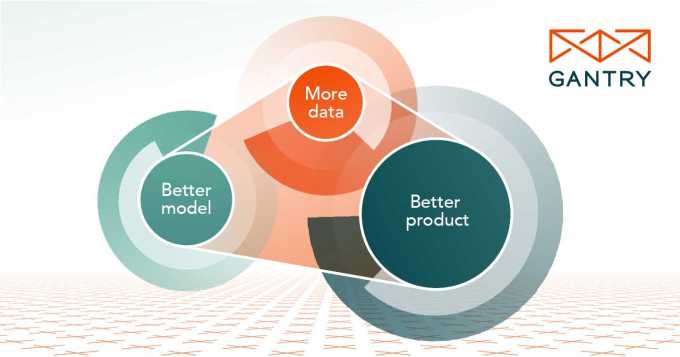Gantry launches out of stealth to help data scientists keep AI models fresh
The demand for AI in the enterprise is insatiable, but the challenge lies in building the infrastructure to support and its development and maintenance. A 2020 IDC survey found that a shortage of data to train AI and low-quality data remain major barriers to implementing it, along with data security, governance, performance, and latency issues. […]

The demand for AI in the enterprise is insatiable, but the challenge lies in building the infrastructure to support and its development and maintenance. A 2020 IDC survey found that a shortage of data to train AI and low-quality data remain major barriers to implementing it, along with data security, governance, performance, and latency issues. In fact, a third of enterprises responding to the poll report spending around a third of their AI lifecycle time on data integration and prep versus actual data science efforts.
Josh Tobin, a former research scientist at OpenAI, observed the trend firsthand while teaching a deep learning course at UC Berkeley in 2019 with Vicki Cheung. He and Cheung saw the history of AI reaching an inflection point: Over the previous ten years, companies invested in AI to keep up with tech trends or help with analytics. Yet, despite some vendors declaring the ‘democratization of AI,’ it remained very difficult for most companies to build AI-powered products.
“The main challenge in building or adopting infrastructure for machine learning is that the field moves incredibly quickly. For example, natural language processing was considered out of reach for industrial applications just a few years ago, but is rapidly becoming commonplace today,” Tobin said. “That’s why we’re building a continuous machine learning improvement platform.”
Tobin and Cheung, who formerly headed infrastructure at OpenAI and was a founding engineer at Duolingo, are the co-founders of Gantry, a service that aims to help AI development teams decide when to retrain their AI systems and which data to use during retraining. Tobin claims that Gantry, which connects to existing apps, data labeling services, and data storage, can summarize and visualize data during the training, evaluation, and deployment stages.
Gantry today emerged from stealth with $28.3 million, a combination of a $23.9 million Series A round and previously undisclosed $4.4 million seed round. Amplify and Coatue co-led the Series A alongside investors including OpenAI president and co-founder Greg Brockman and Pieter Abbeel, the co-founder of industrial robotics startup Covariant.

Image Credits: Gantry
“Our product helps machine learning engineers use the data that is flowing through their live machine learning-powered product to figure out how the application is really performing, find ways to improve it, and operationalize those improvements,” Tobin said.
AI systems learn to make predictions by ingesting data sets (e.g., historical weather patterns) and learning the relationships between various data points (e.g., temperature tends to be higher on sunny days) within those sets. But AI systems tend to be fragile in the real world because real-world data is almost never static, so the training set isn’t representative of the real world for long. For example, a inventory forecasting system might break because the pandemic changes shopping behavior. Volvo’s self-driving car system was infamously confused by kangaroos, because the kangaroos’ hopping made it difficult to judge how close they were.
Tobin and Cheung believe the answer to this is Gantry’s “continual” learning system — infrastructure that can adapt a system to a continuously evolving stream of data. Gantry is designed to serve as a single source of truth for AI system performance, Tobin said, allowing users to find out how the system is performing and ways to improve it using workflow tools to define metrics and the data slices on which to compute them.
“The days of poor enterprise customer experience are over — customers now expect an experience that is as seamless, consistent, and intuitive as what they’ve come to expect from modern tech companies. Machine learning makes it possible to deliver these experiences at scale. However, machine learning powered products are expensive to build and pose brand and customer experience risk, because models can fail in unexpected and harmful ways when they interact with users,” he added. “Gantry helps enterprises develop seamless machine learning-powered customer experiences with less risk and lower cost by providing infrastructure and controls required to safely maintain and iterate on their machine learning-powered product features.”
Gantry fits into an emerging category of software known as MLOps (machine learning operations), which seeks streamline the AI system lifecycle by automating and standardizing development workflows. Driven by the accelerating adoption of AI, analytics firm Cognilytica predicts that the global market for MLOps solutions will be worth $4 billion by 2025 — up from $350 million in 2019.
Tobin acknowledges that others tools, like Arize, Arthur, and Fiddler, accomplish some of the same things that Gantry does. But he argues that they focus on a broader range of AI problems, whereas Gantry touches on — but goes beyond — aspects like observability, monitoring, and explainability. For example, Gantry can be used to detect bias in AI-powered apps, Tobin claims, even when the apps use “unstructured” data like text and images.
Tobin declined to reveal how many users or customers Gantry has. But he says that the funding will be put toward in part customer acquisition, in addition to expanding the size of Gantry’s 22-person team.
“We think the potential headwinds in tech are more than offset by a strong tailwind in machine learning,” Tobin added, when asked about the current economic climate and what it might mean for Gantry. “Also, as belts tighten and companies become more thoughtful about their spending, investing in tools to help improve teams’ efficiency and products’ performance and reliability become even more important.”







